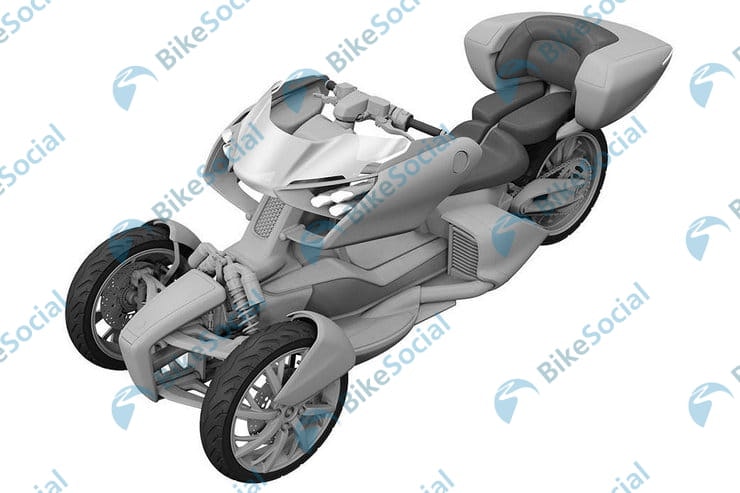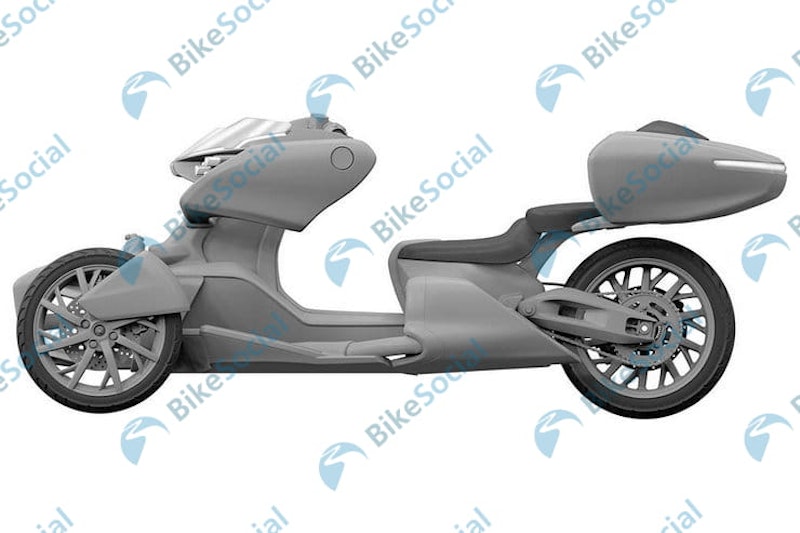Unseen Yamaha concept previews future leaning trike
By Ben Purvis
Motorcycle Journalist
30.06.2020
The cancellation of this year’s major motorcycle shows has had a particularly hard impact on concept bikes – and that might well explain why this unseen Yamaha design has emerged via a low-key styling patent rather than in under the glare of show lighting, accompanied by thumping music and a clattering of camera shutters.
It’s been a while since shows have been used purely for the unveiling of new production models. The advent of the internet means online presentations are increasingly preferred, and by the time a production bike makes its public debut on a show stand it’s normally already graced the pages of magazines and websites. But concept bikes are different. Used as demonstrations of a firm’s future ideas or its design skills, but with no immediate impact on showroom models, they’re brilliant tools for pulling punters to a show stand but not really worthy of an online unveiling without a physical presence.
The design you see in these images might well be a victim of the pandemic that’s closed all those shows. It’s an actor robbed of its stage, but that doesn’t mean its message is any less important than it would have been if it was shown in the metal.
We don’t know precisely when Yamaha was hoping to show this bike, or if there’s still a plan to unveil it in the future, but it’s clear that it’s a development of the MW-Vision concept that was unveiled at last autumn’s Tokyo Motor Show (below). It might well have been planned to appear as a follow-up design at the cancelled Tokyo Motorcycle Show, which was due to have happened this spring, or be intended to appear later this year – perhaps at Intermot in Cologne, which has also been called off.
It’s clear that the design shows a more realistic machine than the MW-Vision while sharing the majority of its components. Where the MW-Vision had a roof and a car-style seat, the design seen here is more motorcycle-like, looking like a big touring bike with an extra front wheel.
The wheels are bigger than the MW-Vision’s, giving improved proportions, and they’re also less concept-like; so it’s easier to imagine this bike joining the rest of Yamaha’s ‘Leaning Multi-Wheel’ range.
Remember, the MT-09-based Niken trike was previewed by two concepts before emerging in production form. It started life as the ‘01GEN’ concept in 2014, developing into the MWT-9 concept the following year and the Niken production bike in 2017. Could Yamaha be following the same route here? It certainly seems possible.
We certainly know that Yamaha has plans for the front suspension system seen on this machine. Featuring car-style front wishbones rather than the telescopic fork design used on the Tricity and Niken trikes, it’s a design borrowed from Norwegian firm Brudeli, which used a similar layout on its low-volume, KTM-based Leanster trike. Yamaha bought the patent rights in December 2017 and has since patented its own versions of the system, notably showing it fitted to a TMAX 560 scooter in its patent drawings.
The firm has also hinted at its plans to add a leaning trike looking very much like this new design. In February 2019, we published images from Yamaha’s mid-term business plan that illustrated the growth of the ‘LMW’ trike range. Yamaha’s plan showed the silhouette of a low-slung leaning trike (below) alongside the Tricity, Niken, 3CT, the Tritown stand-up trike and the MWC-4 leaning four-wheel concept. Of those, only the MWC-4 and the mystery silhouette haven’t reached production; the 3CT is now the Tricity 300, and the Tritown has been made in small numbers for use in parks in Japan.
While a low-slung Yamaha leaning three wheeler with Brudeli-based suspension is likely to reach production, it won’t be identical to the machine you see here.
Technically, this appears to be virtually identical to the MW-Vision, albeit with a more realistic design. While Yamaha never revealed much about the components under the MW-Vision’s wild-looking skin, the firm said it was a ‘series hybrid’ design. That means a vehicle with a combustion engine that’s used to generate electricity that then feeds an electric motor; it’s a design that’s reached production in a small number of cars, but it’s still rather futuristic when it comes to motorcycles.
The new designs give a slightly better look at how the idea might work. It looks like there’s a twin-cylinder engine near the front of the bike, with an exhaust pipe running down each side and exiting from the rear of the ‘side pods’ below the rider’s seat, which also appear to house radiators. The electric motor that drives the rear wheel is mounted below the rider’s seat, driving the rear wheel via a chain.
A series hybrid system also features batteries to store electricity, but they can be much smaller than on a pure-electric bike. Since you don’t tend to use full power very much on a bike, a series hybrid can use a relatively small engine, running at its most efficient throttle opening and only for relatively short periods, to recharge the batteries, while the electric motor could give the performance of a much larger-engined bike for the short periods on demand.
Should the new design follow the pattern of the Niken and be transformed into a production machine – as hinted at in Yamaha’s 2019 mid-term plan – it seems unlikely that the hybrid system will be retained.
What’s not clear is what engine it might use. Yamaha’s plan put the bike high on the ‘Fun’ scale, suggesting sporty performance, and previous patents from the firm have even shown designs for a three-wheeler using the firm’s 1700cc V-Max V4 engine. However, to retain the step-through design make more sense to use a parallel twin engine – perhaps from the MT-07 or the TMAX 560 – with the ‘fun’ coming from the bike’s handling, which, with a low centre of gravity and wishbone suspension, could put it somewhere between a bike and a lightweight sports car.
Yamaha might not have a show platform this year to unveil this concept, but it’s going to be interesting to see where the firm takes its undying interest in the idea of leaning three-wheelers in the future.
Share on social media:

